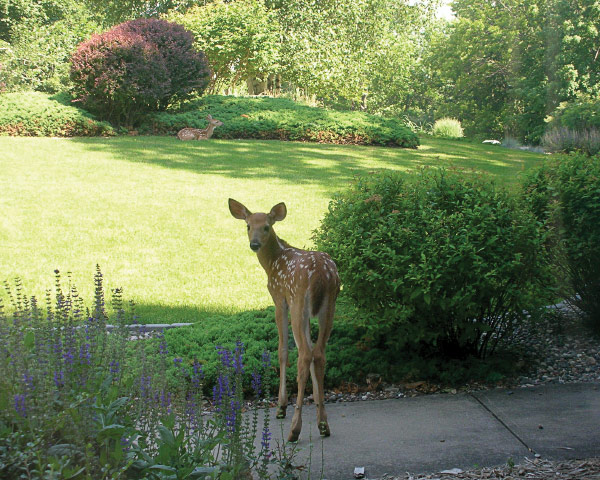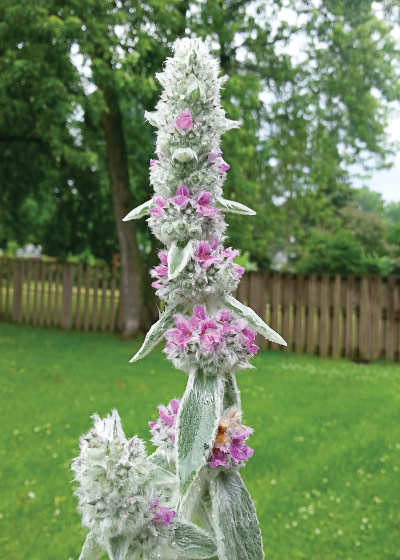Deter Deer from Devouring Your Landscape
 |
|
Two fawns stop by for a visit. Photo by Alan Light, flic.kr/p/55xbj2. |
By Marcia Anderson, PhD, LTE
U.S. EPA-Center for Integrated Pest Management
Last year, before I could muster the energy to plant my flowering perennials, I made the mistake of temporarily leaving them outside. An hour later, I was faced with the harsh reality that my plants’ flowers, buds, and leaves had been bitten off.
The culprits were not very sneaky. I later found a doe and her fawn eating my impatiens, geraniums, and other potted annuals. Sound familiar?
Springtime is the perfect opportunity for deer to gorge on high-protein, moisture-rich plants—especially nursing fawns and underweight adults. An adult deer can eat up to ten pounds of greenery a day.
So, how can a gardener keep deer from eating their landscape?
Implementing an integrated pest management (IPM) approach to managing deer is beneficial to both human health and the environment. This approach is considered smart, sensible, and sustainable because it focuses on preventive—rather than reactive—control steps. IPM also emphasizes the least hazardous physical, cultural, and chemical tactics.
By grounding IPM decisions in biological information about deer (e.g., their preferred food sources), it is possible to implement strategies that require minimum-to-no pesticide use.
Fencing
An effective method for deer exclusion is installing and maintaining a deer fence. However, in many communities, zoning regulations do not permit fencing taller than six feet, an effortless jump for a white-tailed deer.
To manage this problem, install parallel fences within a few feet of each other. This approach is referred to as “double fencing” and inhibits deer from jumping because they cannot see the landing area. Also, installing fences with irregular tops creates an optical illusion.
But recognize that each deer is unique and persistent. A fence that deters one deer won’t always deter another.
Visual and Olfactory Barriers
 |
|
Lamb’s ears in bloom—a plant that deer detest. Photo by Dustin Murrell, flic.kr/p/CGeq7j. |
The fence at my house is only five feet high, hardly an obstacle for a determined deer. However, it is back-planted with deer-resistant shrubs such as boxwood, chamaecyparis (false cypress), andromeda, holly, and weigela. These shrubs act as a deterrent because they obstruct a deer’s view and confuse its sense of smell. Pungent plants such as garlic, chives, mint, lavender, lemon balm, bee balm, and oleander can mask the scent of desirable plants.
Consider avoiding the desirable plants in the first place. Deer are very attracted to impatiens, sunflowers, tulips, hostas, daylily and daisy varieties, yews, arborvitae, and hyacinth. Try replacing these plants with varieties that deer do not enjoy, such as daffodils, lily of the valley, lamb’s ears, lavender, Russian sage, liriope, pachysandra, and myrtle. Deer also do not like ornamental grasses, iris, foxglove, or yucca.
Some shrubs act as a deterrent because they obstruct a deer’s view and confuse its sense of smell.
But if you are not willing to replace the beautiful sunflowers, tulips, or daisies in your garden, no need to fret! I happen to really like daisies, so I still plant them, but I also plant marigolds, lupine, and sage around them. Deer especially detest the scent of marigolds and avoid lupine as it makes them sick.
You can learn more about deer-resistant plants—including those that will work in your hardiness zone and with your yard’s sun and soil types—by consulting your state or local government’s department of natural resources website, or a master gardener or landscape professional in your area.
Chemical and Physical Repellents
There are many effective commercially available deer repellents. However, chemical methods typically require maintenance (i.e., reapplication after each time it rains). Also, it’s prudent to alternate the types of repellents you use so that deer do not become acclimated.
Before you apply any chemical-based deer repellent, read the product label directions, and check your state regulations to see if it must be applied by a licensed applicator in accordance with other restrictions.
Other repellent products include sewage sludge fertilizer or sewage-derived mulch products. If you use these products in or near a vegetable garden, be cautious of their potential heavy metal content (Belhaj et al., 2016).
Even when using the more creative deterrent strategies—such as aluminum pie plates, streamers, lights, soap, or coyote urine—remember that deer acclimate to most distractions. Always alternate your repellent strategies for best results.
For More Information
These tips should help you naturally deter deer and keep the fruits of your labor—your garden and your landscape—intact.
For more information from professionals in this field, view EPA’s webinar on integrated deer management at youtu.be/wsCfaHX1EZo.
Reference
Belhaj, D., N. Elloumi, B. Jerbi, M. Zouari, F.B. Abdallah, H. Ayadi, and M. Kallel. 2016. Effects of sewage sludge fertilizer on heavy metal accumulation and consequent responses of sunflower (Helianthus annuus). Environmental science and pollution research international, 23(20), 20168–20177. doi.org/10.1007/s11356-016-7193-0
The Northeastern IPM Center promotes integrated pest management for reducing risks to human health and the environment. If republishing our news, please acknowledge the source (“From Northeast IPM Insights”) along with a link to our website.
